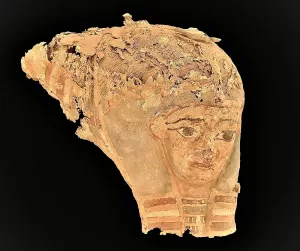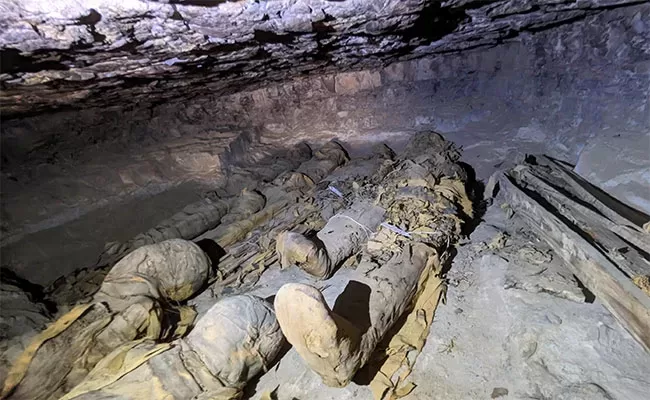Discovered within a stone coffin are the mummified remains of an adult, likely female, and a child believed to be around one to two years old, still interlocked.
The tomb also holds fragments of colourful cartonnage, clay figures, and offerings tables.
This find is part of a collection of 33 family tombs from the late period and Greco-Roman era, previously unknown until uncovered by a collaborative Egyptian-Italian archaeological team near the Aga Khan Mausoleum in the western region of Aswan in Upper Egypt.
As per the Ministry of Tourism and Antiquities, the recent find unveils a fresh chapter in the history of the Aga Khan area.

Notably, several tombs uncovered in this discovery remarkably retain mummy fragments and remnants of burial artefacts.
“This revelation enriches our understanding of the era and prevalent diseases of that time,”the ministry said.
Analysis on the mummified remains within these tombs suggests that around 30% to 40% of the interred individuals passed away in their early years or from infancy to young adulthood.
The Mausoleum of Aga Khan III, Sultan Mohamed Shah, who passed away in 1957, is situated on the Nile.
This location was significant as it was once the powerhouse of the Fatimid dynasty which was a prominent Ismaili Shia ruling family.
Construction work on the mausoleum commenced in 1956 and concluded in 1960.
It was built under the patronage of Aga Khan’s wife, Begum Om Habibeh Aga Khan.
Originally welcoming visitors, the interior of the mausoleum was restricted from the public in 1997.
As a tradition, a red rose is daily placed on Aga Khan’s tomb, a custom initiated by Begum Om Habibeh Aga Khan.
Perched on a hill on the western bank of the Nile, the mausoleum offers views of Aga Khan III’s and Begum Om Habibeh Aga Khan’s winter residence, known as the Prince Sadruddin Aga Khan House.
This villa was created by renowned Egyptian architect Hassan Fathy and was where Aga Khan III spent the colder months. His wish was to be buried close to this villa, and it was fulfilled two years after his death.
The architectural design of the recent unearthed tombs revealed a variety of styles. Some featured a grand vaulted entrance set within an open courtyard enclosed by sturdy mud brick walls, while others were intricatelycarved into the natural mountain rock.

 Abdel-Moneim Saeed, the general supervisor of Aswan and Nubia antiquities and leader of the mission on the Egyptian side, said the findings suggest that the middle class of Aswan’s past population was interred in the lower part of the necropolis, while the upper echelons were laid to rest in the upper part.
Abdel-Moneim Saeed, the general supervisor of Aswan and Nubia antiquities and leader of the mission on the Egyptian side, said the findings suggest that the middle class of Aswan’s past population was interred in the lower part of the necropolis, while the upper echelons were laid to rest in the upper part.
Moreover, thorough studies and cutting-edge radiological analyses were performed on the mummies to unveil a comprehensive understanding of their features, including facial characteristics, gender identification, age at the time of death, and whether the demise was a result of natural causes or illness.
Italian archaeologist, Patrizia Piacentini, a professor of Egyptian archaeology at the University of Milan and the head of the mission on the Italian side, revealed that initial examinations indicated a prevalence of infectious diseases and bone disorders among the mummies.
Among the findings were noticeable indications of amputation in the pelvic area of adult women, evidenced by specific bone trauma, he said.
The studies further unveiled signs of anaemia, malnutrition, chest diseases, tuberculosis, and osteoporosis in various mummies.
Piacentini noted that some individuals died at advanced ages, while others suffered from severe bone ailments.
Egyptologist Abdelrehim Rihan referred to the significance of the discovery that revitalises the ancient city of Aswan.
Regrettably, he said, the city has been overlooked by UNESCO, not being encompassed within the World Heritage registration boundaries set in 1979.
At that time, only Nubian monuments stretching from Philae to Abu Simbel were duly recognised, he said.
UNESCO’s omission extended to heritage sites in Edfu, Esna, KomOmbo, and various monuments within Aswan itself, distinct from the Nubian structures.
Consequently, there is a pressing need to compile a comprehensive dossier for their inclusion in the esteemed World Heritage list, he told local media.
Aswan boasts enduring tourist attractions, with the most recent addition being the monumental High Dam.
A marvel of engineering, the dam stands as the world’s largest construction project of the 20th century.
The High Dam’s pivotal role in shielding the country from the annual menacing floods of the Nile cannot be overstated.
Its construction, not only averted catastrophic inundations that imperilled Egypt each year,but also generated a substantial amount of electricity, benefitting the region immensely.






Discussion about this post